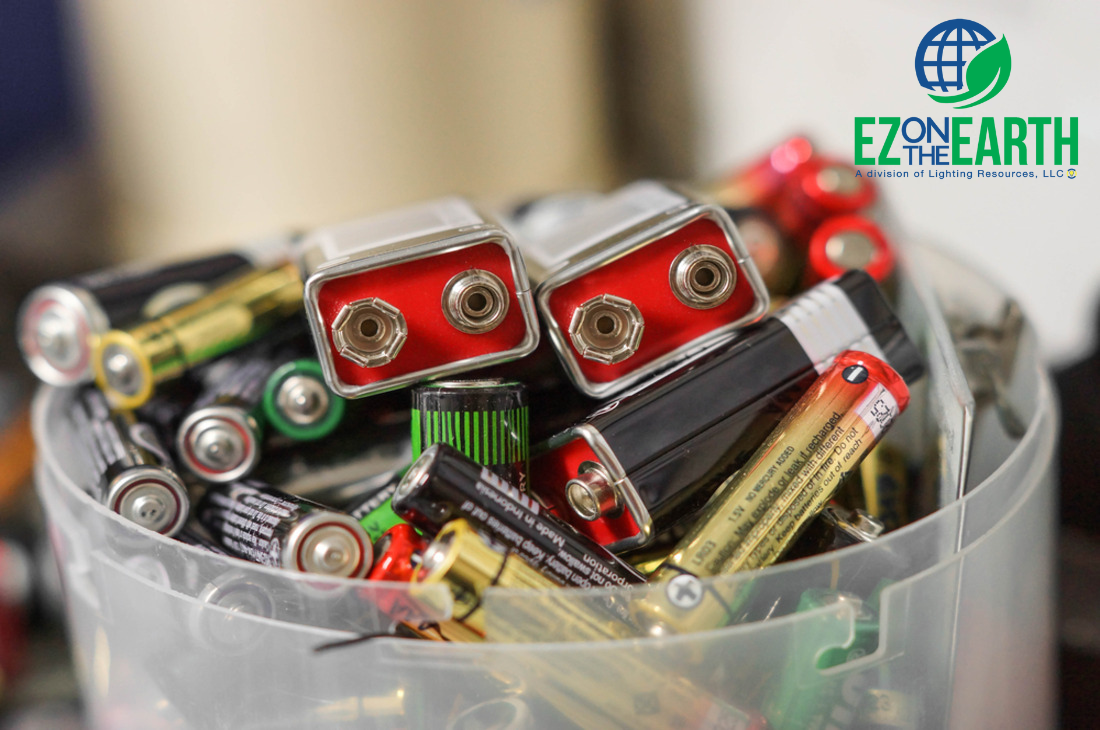Batteries are one of the most common items used in businesses and homes that also cause a great deal of confusion when it comes to recycling. And it’s no wonder. There are dozens of different kinds of battery chemistries, which makes them difficult to identify — and not to mention, the federal and state regulations for proper disposal are extremely complex.
In general, batteries are regulated as Universal Waste by the Environmental Protection Agency (EPA), with a few exceptions like alkaline batteries. A Universal Waste designation means that it is the responsibility of the generator of batteries to properly ship and dispose of batteries. Please refer to all pertinent regulations including United States Department of Transportation (USDOT), United States Environmental Protection Agency (USEPA), and state and local regulations; this article is intended to provide general guidelines.
So how do you properly package, store, and recycle your used batteries? There are some general guidelines you can follow for most types of batteries.
(In this post, we’re going to focus on general battery packaging and storage and not get into the nitty gritty of identifying the different types of batteries.
You can learn more about battery chemistries here.)
How to package batteries for storage
There are two main reasons that batteries need to be recycled:
- Nearly all batteries contain toxic materials that need to be properly recycled so they don’t leach and contaminate soil and drinking water.
- Some batteries can self-ignite and catch fire if they are not properly packaged before disposal.
The most important issue to address when batteries are stored for disposal is to ensure battery terminals are properly insulated to avoid sparking and shorts. The general interpretation of the USDOT and USEPA regulations is to use clear tape to fully insulate all lithium battery terminals, and all terminals for other battery chemistries over 9 volts. Do not ever mix any damaged batteries with other batteries designated for disposal. Call a hazardous waste provider when managing damaged batteries.
Short circuiting, or sparking, can be incredibly dangerous when battery waste material is being transported — think potential fires in transportation vehicles like trucks and planes.
As a general rule, lithium batteries always need to be insulated, or taped, before they are stored. Lithium batteries will always have a lithium mark on their label, which makes them easier to identify. A couple of examples of common lithium batteries include:
- The new longest-lasting AAA batteries that are made of lithium metal. They are ultra-light, look like AA alkaline, and contain a lot of energy. They will self-ignite if not properly disposed of.
- AA batteries that say lithium on the label.
In addition, any batteries over 9V (with button cell terminals on top) must also be insulated before they’re disposed of.
Our motto is: When in doubt, tape the terminals.
How to store batteries
Batteries that are regulated as a Universal Waste by the EPA require most businesses to recycle or dispose of these wastes at permitted facilities within 12 months, with a few exceptions. Check with state and local regulations, as they may be more strict.
One of the easiest ways to store batteries is to order prepaid mail-back recycle kits from EZ on the Earth. These kits are covered by a special USDOT permit to allow for the mixture of some battery chemistries providing the batteries are not damaged and the terminals are properly taped.
When shipping or storing in containers other than mail-back recycle kits, batteries need to be placed in a container with a heavy-duty plastic liner. It is also important to sort batteries by battery chemistry. Also, according to USDOT regulations, lithium batteries cannot be shipped in containers over 66 pounds. As of January of 2019 lithium battery shipments are also required to include a specific lithium warning marking. In addition to the specific lithium marking, UN numbers for the type of lithium battery must be included as well as a toll free number monitored 24 hours per day.
EZ on the Earth recycling kits contain fire-resistant insulation for storage up to one year from the time the first battery is added to the kit. After 12 months, EZ on the Earth kits provide complete instructions for packing and mailing materials to one of our recycling facilities for reuse.
Learn more about Recycling batteries
Lighting Resources and EZ on the Earth make battery recycling simple. Learn more about our mail-back recycling kits and our bulk recycling capabilities. And if you have any questions about battery insulation or storage, please contact us so we can help.

